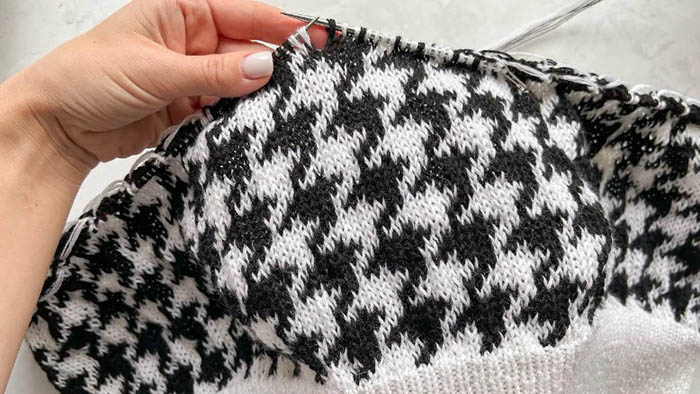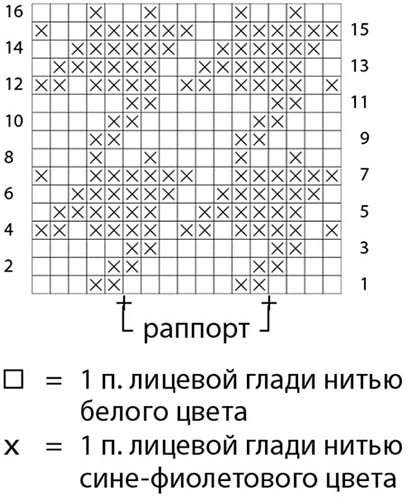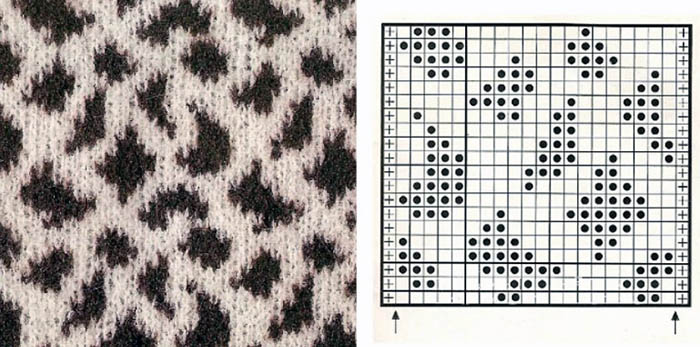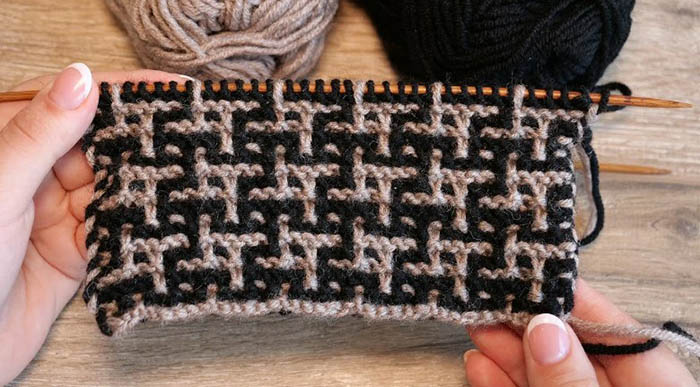The "Goose Feet" pattern is especially popular and in high demand among knitters. This type of ornament is often used to create various decorations, adult and children's clothing.
The classic option is considered to be two-color pattern designHowever, there are other knitting patterns for the houndstooth pattern.
Necessary tools and materials
The Goose Feet pattern with knitting needles (the diagram with the description will allow you to make the drawing easily and quickly) is mainly suitable for decorating warm clothes in the form of a scarf, sweater and other clothes.

It is recommended to use thread material made of natural goat, camel, sheep wool. Alpaca or merino wool yarn is considered not very prickly material. However, goat down fabric will be soft to the touch.
Experienced knitters recommend using yarns that are made up of equal amounts of acrylic and wool. If you need to knit clothes for the cold winter season, the yarn should be 70% wool.
Thick threads, which are less than 100 m per 100 g, are not suitable for knitting warm clothes. This is due to the fact that the seams will be rough. As a result, when putting on a jacket or coat on top, a person will feel uncomfortable and tight.
When choosing a thread material for warm clothes, you also need to consider the model that needs to be made:
| Purpose | Suitable yarn |
| For women | In this case, it is better to use thin thread material made of silk, cotton and wool. |
| For men | Often, clothing is made from coarse sheep wool or prickly, rough camel wool. |
| For children | It is recommended to use several types of material in the form of grass, chenille or plush, which will not irritate the skin. |
For knitting the pattern, it is advisable to take knitting needles that are 1 size smaller than the thread material. Due to this, the finished garment will retain its shape, and the knitting will have a high density.
However, to add airiness to the product or when knitting children's clothes, it is better to use needles one size larger. As a result, the knitted fabric will be soft and will not irritate the skin.
Schemes with description of works for beginners
Thanks to the patterns with detailed descriptions, beginner knitters will be able to easily and quickly knit the "Goose Feet" pattern in any technique.
The classic way
The Goose Feet pattern with knitting needles (the diagram often includes the classic way of decorating the ornament) must be decorated with a drawstring on the back of the fabric. As a result, the product made of the front surface will be warm and dense. The pattern is often used to decorate a hat, cardigan, skirt, jacket and sweater.

To knit a classic ornament, it is recommended to prepare yarn of light and dark shades. It is recommended to decorate the edge stitches with the material from which the first row of the rapport begins. Light threads are suitable for this. The rapport of the ornament should consist of 4 loops and a similar number of rows.
Step-by-step description of knitting:
- Make a set of the required number of stitches, which will be a multiple of 4. Additionally knit 2 edge elements.
- The preparatory line should consist of purl stitches knitted with a light thread.
- In 1 row, make 2 front loops with light yarn. Then make 1 front loop with dark threads, and 3 front elements with light material. Repeat this step from the beginning to the end of the row. At the end, make 1 front loop with dark yarn and 1 front loop with light threads.
- In the 2nd row, alternately knit 1 purl stitch with light yarn until the end of the row, and 3 purl elements with dark material.
- The 3rd row consists of 1 front loop, knitted with light yarn, and 3 front stitches, decorated with dark threads. Repeat the alternation of stitches until the end of the row.
- In the 4th row, initially make 2 purl elements with light threads. Then, until the end of the row, alternately knit 1 purl with dark material and 3 purl elements with light. At the end of the line, make 1 purl and 1 purl loop with dark threads and 1 purl with light threads.
- Repeat the pattern from rows 1 to 4.
In jacquard technique
To create a jacquard pattern, you need to cast on 6 stitches and 2 edge elements. For knitting, it is recommended to prepare black and white threads that have the same density and texture.

Step by step instructions:
- In 1 row with white yarn make 1 edge stitch at the beginning and end of the row. Then between them alternately knit a loop with a throw over, put the thread behind the fabric and make 5 front stitches.
- In the 2nd row, initially knit the edge element with white threads. Then make 5 purl and 1 loop with a throw over, the thread should be in front. Repeat until the end of the row. At the end of the row, make an edge stitch.
- Knit the 3rd row with black threads. At the beginning of the row, make an edge stitch. Then knit 5 front and 1 element with a yarn over, the yarn should be behind the fabric. Repeat until the end of the row. At the end of the row, make an edge stitch.
- In 4 rows, make an edge element with black threads. Make 1 loop with a throw over, place the thread in the front of the fabric and knit 5 purl stitches (repeat until the end of the row). To complete the row, make an edge stitch.
- 5 line make with white threads. First make an edge stitch. Knit 3 loops with a throw, place the material behind the canvas, make 1 front and 1 element with a throw, the material should be behind the canvas, then make 1 front stitch (repeat to the end of the row in turn). At the end of the line make an edge stitch.
- Row 6 is knitted with white material. The first should be the edge element. Knit 1 purl and 1 element with a yarn over, place the yarn in front of the fabric, again make 1 purl and 3 loops with a yarn over, placing the thread in front of the work (alternately repeat until the end of the row). Make an edge loop.
- 7th row is designed with black yarn. There should be 1 edge stitch at the beginning and end of the row. Between them, knit 3 front stitches and 1 loop with a yarn over. The yarn should be behind the fabric to design the next 2 front stitches (alternate until the end of the row).
- Knit the 8th row with black material, making 1 element at the beginning and at the end. Between the edges, make 2 purl and 1 loop with a throw, the material should be in front of the work for knitting 3 purl elements (alternate until the end of the row).
- Row 9 is decorated with white yarn. There should be 1 edge loop at the beginning and end of the row. Between them make 2 front stitches and 1 stitch with a yarn over. Place the material behind the canvas and knit 3 front elements (repeat to the end of the row with alternation).
- Row 10: Make with white yarn. Between the edge loops at the beginning and end of the line, knit 3 purl and 1 loop with a yarn over, bring the thread in front of the work and make 2 purl stitches (repeat with alternation).
- In the 11th row, at the beginning and end, make 1 edge stitch with black threads. After that, between them, knit 3 front stitches, 3 elements with a yarn over and put the yarn behind the fabric.
- In row 12, make loops with black material. The edges should be the outermost. Between them, knit 3 loops with a yarn over and 3 purl elements in turn, having previously placed the yarn in front of the fabric.
Simple option
If you don't have much experience knitting the "Goose Feet" pattern, you can use a simple option. In this case, you initially need to dial a certain number of loops, which can be divided by 4.
In this case, you should not include edge stitches in this calculation, because they will not take part in the main ornament. However, these elements must be knitted.
For knitting in this style, you can use white and black yarn. If you don’t like these shades and want to make the product brighter, you can use any shades of thread material.
Step-by-step description of the work:
- 1 line consists of 2 white, 1 black and 1 white stitches.
- In the 2nd row, knit 1 loop with white threads, 3 loops with black threads.
- Line 3 consists of 1 white and 3 black elements.
- In 4 rows, first make 2 white stitches, 1 black element and 1 white loop.
- To continue the process of knitting loops, repeat the steps starting from row 1.
In the technique of lazy jacquard
The Goose Feet pattern with knitting needles (the diagram allows you to make a pattern with lazy jacquard) can be designed using elongated stitches. The lines in the fabric should alternate in shade. In this case, you need to knit 2 lines with a dark thread material, after the 2nd line - with light yarn. You need to start designing the pattern with dark threads.

Initially, you can perform a set of a certain number of stitches, which can be divided by 6. Additionally, you need to knit 2 edge elements.
Step-by-step description of knitting:
- In row 1, remove 1 loop (the yarn should be behind the fabric) and knit 2 front stitches. Alternate loops until the end of the row.
- In the 2nd row, make 2 purl elements, then remove 1 stitch, placing the yarn in front of the fabric. Repeat the steps until the end of the row with alternation.
- The 3rd row consists of 1 knit stitch, 1 slip stitch (the yarn should be behind the fabric), 3 knit stitches and 1 slip stitch (the material should be tucked behind the fabric). Continue alternating to the end of the row.
- In the 4th row, remove 1 element (the yarn should be behind the fabric), knit 3 purl elements, remove 1 loop (place the material in front of the product) and make a purl stitch. Repeat the actions, alternating until the end of the row.
- In the 5th row, make 2 front elements and remove 1 loop (yarn behind the fabric). Then knit 1 purl stitch, remove (the yarn should be behind the work) and knit 1 purl element again. Alternate loops until the end of the row.
- Row 6 consists of 1 purl, 1 slip, 1 purl, 1 slip and 2 purl stitches. When slipping the stitch, the yarn should be in front of the fabric. Alternate actions until the row is finished.
- Row 7 consists of 1 slipped, 2 knit, 1 slipped and 2 knit stitches. When slipping a stitch, pull the yarn behind the fabric. Repeat alternation to the end of the row.
- In row 8, knit 2 purl stitches and remove, placing the yarn in front of the fabric. Then make 3 front loops and 1 removal, placing the material behind the fabric. Repeat with alternation to the end of the row.
- Line 9 consists of 1 knit, 1 slipped, 3 knits and 1 slipped element. When slipping, the thread material should be behind the product.
- In row 10, first make a slip, with the yarn in front of the fabric. Then knit 3 purl loops, make a slip (bring the yarn in front of the fabric) and make 1 purl stitch. Alternate loops until the end of the row.
- In the 11th row, make 2 purl stitches, leave the material behind the canvas and remove 1 element. Then knit 3 and 1 purl stitches, between which it is necessary to make 1 removal. In this case, the material should be in front of the canvas. Repeat the steps until the end.
- Row 12 consists of 1 purl, 1 slip, 1 purl, slip and 2 purl stitches. Each time you slip 1 stitch, the yarn should be in front of the fabric. Repeat the alternation of actions until the row is finished.
- To continue the pattern, repeat all steps, starting with line 1.
Volume
The Goose Feet pattern with knitting needles (the diagram allows you to knit a voluminous ornament that is suitable for warm clothes) in this technique requires a set of loops, the number of which can be divided by 7. Additionally, you need to knit edge stitches, which should not be included in the calculation of the pattern.

Step-by-step description of the work:
- In the 1st row, make 3 stitches with dark material. Then, alternately knit 1 light and 6 dark elements. To finish the stitch, make 1 loop with light threads and 3 with dark threads.
- In the 2nd row, knit the stitches according to the pattern. Use dark material to decorate those elements that were knitted in the 1st row in a similar color. Use light yarn to decorate those loops that were decorated in the 1st row in a light tone.
- Row 3 is similar to row 1.
- In the 4th and 5th rows, knit 4 stitches with dark yarn. Then make 1 element with light threads, 6 with dark threads (repeat alternation to the end of the row). To complete the row, make 1 element with light yarn, 2 with dark yarn.
- In the 6th row, make 5 stitches with the light material and 2 with the dark material. Repeat the alternation of loops until the end of the row.
- Row 7 consists of 1 light, 1 dark, 3 light and 2 dark stitches. Alternate loops until the end of the row.
- In the 8th row, initially make 2 dark loops. Then knit 4 stitches with light yarn, 3 with dark yarn (alternate until the end of the row). To finish the line, make 4 loops with light threads, 1 with dark threads.
- In rows 9 and 10, make 4 elements with dark threads. Then alternate 1 light and 6 dark loops until the end of the row. At the end of the row, knit 1 light and 2 dark loops.
- From row 11, repeat the pattern, starting with row 1.
Secrets for Beginners
There are a large number of knitting patterns for the "Goose Feet" pattern.

However, when choosing any method of knitting a pattern, you need to take into account several useful recommendations:
- Skeins of thread that have been wound on a winder or industrially are often sold. Such yarn has a hole in the middle, from where it is desirable to take the thread material, but not from the front side. Thanks to this, the thread skein will remain in place during work and will not get tangled.
- If the thread material is light in color, it is recommended to use dark knitting needles and vice versa. Due to this, you can normally see the knitted loops.
- When choosing the classic option, the number of stitches should be such that it can be divided by 4. In this case, 3 additional elements should always be added to the total number of loops to maintain balance. However, the total number of elements should not include the number of edge stitches.
- When purchasing circular knitting tools, the line may be unruly and bent. To correct the situation, it is recommended to immerse the line in very hot liquid for about 3 seconds. After that, the product must be removed from boiling water and left for 120 seconds.
The "Goose Feet" pattern can be knitted quickly and easily thanks to its small rapport. At the same time, there are a large number of different patterns for creating an ornament that are suitable for adult and children's clothing in the form of overalls, pants, and sweaters. This pattern looks original and beautiful if you use melange material for work.
Video about knitting
Master class: knitting pattern "Goose feet":
